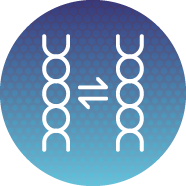As technical capabilities progress, a variety of fields in science and technology tend to intersect more frequently than they did in the past.
 In the field of bioinformatics, computer science combines with biology. Bioinformatics includes the retrieval, organization, and analysis of biological data. This field can employ many technologies. Examples of developments where bioinformatics may play a pivotal role are:
In the field of bioinformatics, computer science combines with biology. Bioinformatics includes the retrieval, organization, and analysis of biological data. This field can employ many technologies. Examples of developments where bioinformatics may play a pivotal role are:
- Biochip patenting and analysis
- Biopolymer sequence analysis. For example, the sequencing of DNA fragments, proper alignment of sequences, and genome assembly relating to genetic pathologies and cancer-related mutations.
- Cellular function analysis, such as modeling of biological pathways, microscopy imaging, and data analysis
- Computer-aided disease diagnosis and drug design
- Gene and protein expression analyses, such as serial analysis of gene expression (SAGE), tag sequencing, massively parallel signature sequencing (MPSS), mass data matching against predicted masses from protein sequence databases, promoter analysis, motif sequencing in the DNA surrounding the coding region of a gene, and algorithm clustering that determines which genes are co-expressed
- Image databases and methods for search and identification
- Instrumentation patenting and analysis
- Microarray analysis
- Software systems and processes, such as data mining, discovery tools for promoter elements, modeling of exons or regulation motifs, and prediction algorithms
- Structural biology and crystallography
Bioinformatics weaves together numerous disciplines, including computer science, statistics, mathematics, and engineering. Many attorneys at Hamilton Brook Smith Reynolds have advanced degrees and industry experience in these areas, enabling us to assemble a specific team based on the technology to be patented.
In particular, our experience includes various computer analyses of genomes and gene sequences (exons and motifs). Many analyses involve a database storing gene sequence information. Some analyses are disease specific or relate to determining cell function and regulation. As an example, we have prepared and filed patent applications directed to a computer search tool that supports a database for use in analyzing genomes.
We also have drafted patent applications for combined neural networks and decision trees to perform robust allele calling and provide an automated genotyping method and system.
Our litigation experience includes:
- Represented a world-renowned cancer research and treatment hospital as the junior party in related patent interferences involving DNA, protein and method claims. Even though we represented the junior party, the opposing party conceded priority as to the most significant claims, resulting in the entry of judgment adverse to the opposing party on those claims.
















